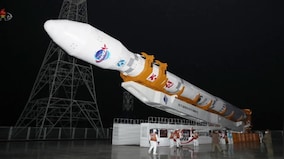As Taiwan’s newly democratically elected President, Lai Ching-te, took the oath on May 20, China immediately responded with ‘punishment’ military drills around Taiwan. Lai had vowed to continue Taiwan’s defence and foreign policy of avoiding tensions with China while also standing up for the island’s democracy’s freedoms. The two large-scale military drills by China surrounding Taiwan were meant to “reprimand” for the so-called “separatist acts”. Beijing has a habit of using intimidation tactics.
With the rise of China and its belligerent act of usurping nearly 3 million square kilometres of the South China Sea (SCS), the Indo-Pacific has become the new region for global geopolitics and confrontation. The “Quad” alignment between the US, Japan, Australia, and India is a tacit anti-China grouping. Japan and South Korea are increasing their military spending and strength. The US-backed Taiwan is no walkover for China.
‘Joint Sword-2024A’ Military Exercise
The “Joint Sword-2024A” exercise that began on early 23rd morning was conducted at five zones encircling the island country. The drills were suffixed with “A”, implying potential follow-ups, reports said. The area covered was larger than the exercises of August 2022, coinciding with US Speaker Nancy Pelosi’s visit. They also took place in areas around Taiwan’s islands of Kinmen, Matsu, Wuqiu, and Dongyin, located just off China’s south-eastern coast.
The exercise was meant to send intimidating signals to the newly elected Taiwanese President, a warning for Taiwanese independence forces, and against interference and provocation by external forces.
The drills focus on joint sea-air combat readiness patrols, precision strikes on key targets, and integrated operations inside and outside the island chain. It involved dozens of Chinese fighter jets carrying live ammunition and conducting mock strikes against “high-value military targets” of the “enemy,” flying alongside destroyers, frigates, and missile speedboats.
All PLA elements, including the rocket forces, were involved. China deployed 15 naval and 16 coast guard ships, but no live-fire drills were held in any areas close to Taiwan. The J-20 and J-16 fighter jets, the Type 052 destroyer and Type 071 amphibious transport dock, and the Dongfeng ballistic missile participated. No Chinese aircraft carrier was reportedly involved in the drills. The second day was for “testing the capabilities of joint seizure of power, joint strikes, and key area control,” said Senior Col. Li Xi, a spokesperson for the Chinese Eastern Theatre Command.
As many as 49 Chinese aircraft, 35 of which crossed the Median Line into Taiwan’s air defence identification zone (ADIZ), were detected on the radar. The Median Line is an informal demarcation point in the Taiwan Strait that Beijing does not recognise but, until recent years, was largely respected. Taiwan put its military units on alert and scrambled jets in response. The Focus Taiwan website released a map of five exercise areas around Taiwan (figure below).
The Political Signalling
After what happened to Hong Kong, Taiwan realised that there is nothing like “One Nation, Two Systems” in China. Taiwan’s resolve to remain an independent, free democracy strengthened.
In Lai’s first address, he said that “the Republic of China, Taiwan, is a sovereign and independent nation with sovereignty resting in the people” and stressed that his government would make no concessions on its democracy and freedoms. Beijing strongly objected to what they viewed as an attempt to develop a comprehensive ‘Taiwan independence’ narrative.
Taiwan sees an unprecedented third consecutive term in power for the ruling Democratic Progressive Party, which is detested by Beijing as a “dangerous separatist” for championing the island’s sovereignty and distinct identity. Beijing has denounced Lai’s inauguration speech, during which he called on China to cease its intimidation of Taiwan.
China’s ruling Communist Party says Taiwan is part of its territory, despite never having controlled it, and has vowed to take the island by force if necessary. Of late, China has started claiming the Taiwan Strait as an internal waterway. Under Xi Jinping, China has grown more assertive and ramped up diplomatic, economic, and military pressure on Taiwan. China’s military drills are also meant to play to a domestic audience as well as for international signalling.
Victor Gao, Chair Professor at Soochow University in China, believes that Lai’s May 20 speech was a declaration of war because he clearly distinguished China from Taiwan and completely destroyed the one-China principle. The Chinese state-run Global Times tabloid described Lai’s speech as “vile behaviour” and claimed it was “filled with hostility and provocation, lies and deception”.
“There’s no surprise. Whenever there’s an action that highlights Taiwan in the international sphere, the Chinese feel compelled to make some statements,” the U.S. Indo-Pacific Command spokesperson said. China’s latest drills are “an intimidation tactic, part of a pattern, not a sign of imminent war.” But these exercises are part of the PLA’s long-term, strategic preparations to fight and win a war over Taiwan.
Taiwan’s Response
President Lai said he would “stand on the front line” to defend Taiwan, without directly referring to the ongoing drills. Taiwan’s 23 million people have long become used to the threat of China’s war drills, and on Thursday, life continued as normal in the capital, Taipei. “We stand by with firm will and restraint. We seek no conflicts, but we will not shy away from one. We have the confidence to safeguard our national security,” said Taiwan’s presidential spokeswoman, Karen Kuo. “It is regrettable to see China threatening Taiwan’s democracy and freedom and regional peace and stability with unilateral military provocations,” she added.
Taiwan’s Defence Ministry released a statement condemning China’s drills as “irrational provocations and actions that undermine regional peace and stability”. It also highlights “China’s militaristic mentality”, they added. Adding that the latest military exercises were being carried out “under false pretences” and highlighted Beijing’s “hegemonic nature”.
Taiwan responded by deploying air, ground, and sea forces, vowing to “defend freedom”. They transported Hsiung Feng III (HF-3) supersonic anti-ship missiles to the coast in response to China’s drills.
China’s Military Capability to Invade
To date, China has insisted on and prevented foreign military bases in Taiwan and the deployment of nuclear weapons. The PLA Rocket Force (PLARF) could be a major threat to Taiwan. The PLARF operates both nuclear and conventional ballistic and cruise missiles. China has qualitatively and quantitatively upgraded its conventional and nuclear forces. China also has anti-shipping missiles. The numbers are significant and going up. Hypersonic weapons have been tested and are operational.
China has the world’s largest naval fleet by numbers, although they are much behind the USA in tonnage. The assault and transport ship capacities are going up. The fusion of civil and military assets will bring in inter-island ferries as troop transports. They have also erected a mock-up of a US aircraft carrier at a field firing range for practice attacks.
Airpower would be very important for the invasion. The PLA Air Force (PLAAF) has inducted the indigenous J-20 stealth fighters. Satellites and Unmanned Aerial Vehicles (UAV) are engaged in sea surveillance and reconnaissance and also act as communication relays. The PLAAF has many airbases closer to Taiwan, giving it significant strike capability. Achieving air superiority will be important for both the maritime blockade and any amphibious invasion. China would carry out simultaneous cyber and electromagnetic attacks on Taiwanese sensors and command and control networks. PLAAF and PLA Naval Aviation can field over 1,200 combat aircraft. Two Chinese aircraft carriers are deployable. PLAA has six Amphibious Combined Arms Brigades, and is working to expand its numbers. They will use both civil and naval vessels. PLAAF’s Airborne Corps can lift around 11,000 troops and related equipment.
Complexities of Invading Taiwan
China’s aggressive air and maritime forays into Taiwanese territory over the years have been creating conditions and preparing grounds for a smooth transition from peace to war. It also makes it difficult to assess the intentions and timing of the actual assault, thus keeping Taiwan under fear of uncertainty.
Any invasion would mean crossing the Taiwan Strait, which is 128 km wide at its narrowest point. The invasion would involve a major amphibious task force, the landing and transport of soldiers, armoured vehicles, artillery, ammunition, fuel, food, and medical supplies. Before all this can be done, China would have to run an air and surface campaign to suppress enemy air defences (SEAD). The island would have to be pulverised through missile attacks. After securing some parts of the island, airlifts would follow. The invasion of this scale will require a lot of training and pre-invasion rehearsals.
Some are suggesting that nearly 400,000 troops may have to be transported. A huge sea fleet would have to be assembled. This cannot go unnoticed. Such a fleet would be vulnerable to artillery fire, air strikes, and submarines. Also during both embarkation and disembarkation. China would have to seize Taiwanese airfields to land forces. A highly urbanised country will pose operational hurdles. If China decides to take over some of the many smaller islands before the actual assault, it will expose its plans and invoke global wrath. In any case, some of the larger islands have strong defences.
Blockade Option
It is also feared that China will impose an air and/or maritime blockade. A maritime blockade could physically cut Taiwan off from the world. An air blockade could mean establishing air supremacy and a no-fly zone over Taiwan. It would require a multi-domain attack through electromagnetic spectrum control and cyberspace to cripple Taiwan’s command and control system. With a heavy US presence in the region, the same may not be easy or without serious incidents. China’s military still has limitations in range and reach to take on a possible US and Japanese intervention.
Taiwanese Defences
For its defence, Taiwan has early warning through ground-, ship-, and airborne sensors. Taiwan has some of the highest elevations in the Indo-Pacific region, with more than 200 peaks topping 3,000 m, and the highest “Yushan” being 3,952 m. Taiwanese radars can see hundreds of miles into Chinese territory. Taiwan also has US PAVE PAWS radar that can detect PLA ballistic missile launches thousands of kilometres away. The Taiwanese air force has over 400 fighter aircraft, of which nearly half are 4th generation plus upgraded F-16s and French Mirage 2000 fighter jets.
Taiwan’s main military strength is in its air defences. The fighter aircraft are well protected in hardened shelters and mountain-caves. They have the most modern networked American AD weapons. Any preemptive surface missile attack would tantamount to full-scale conflict and would face a military response. Taiwan has the capability and military strength to absorb the initial missile barrage.
Taiwan would have to defend ports and airbases. Taiwan has good runway repair capability, and can recover one in less than three hours. Taiwanese command and control centres are also underground and well protected with backup centres. The military carries out regular training exercises, including take-offs and landings from highways.
Conscious of Chinese incursions, Taiwan regularly exercises its early warning system. Taiwan also closely monitors and tries to enforce control in its ADIZ.
The defence of military and civil networks from cyberattacks will be critical. Taiwan already faces and successfully defends many Chinese cyberattacks daily. Taiwan has a small but credible cyber force managed by the newly created Cyber Security Agency. Taiwan is also increasing indigenous defence production.
The US’ Support
Though the West, including the US, had committed to “One China” policy, but there are more voices in the American security establishment that call for defending Taiwan for America’s economic interests, democracy, and international standing.
As per the US Taiwan Relations Act (TRA), “the United States shall provide Taiwan with arms of a defensive character and shall maintain the capacity of the United States to resist any resort to force or other forms of coercion that would jeopardise the security, or social or economic system, of the people of Taiwan”. The US military has a sizeable presence in the region and provides air defence alerts to its allies, including Taiwan.
The US allocates large sums ($9.1 billion) for the Pacific Defence Initiative (PDI). Also, of late, the US Congress has been pushing for more support for Taiwan’s defence preparedness. The newly introduced Taiwan Deterrence Act and Arm Taiwan Act would authorise $2 billion and $3 billion a year, respectively, in foreign military aid to procure defensive systems.
Unlike in Japan and South Korea, there are no U.S. military personnel stationed in Taiwan. Some are suggesting that the U.S. must have a Taiwan Defence Command headquartered elsewhere, but with some forward elements in Taiwan. On average, 100 US officials, including military personnel, visit Taiwan each week. How much physical support the US will give Taiwan in case of an attack by China will have to be seen.
The US already has two aircraft carrier groups in the region, and its Indo-Pacific Command can muster up to five carrier groups with F-35 class fighters, and massive fire power. There are also many cruise missile-carrying ships.
The US also has a significant military presence in the region, including its own islands, including Guam. The US Seventh Fleet is based in Japan. On the Japanese island of Okinawa, the US has huge military assets, including an F-22 squadron that moved recently. The US military is in large numbers on the Korean peninsula. The US Air Force fighters are less than an hour away. The US has bases in the Philippines. U.S. B-2 bombers can operate from Australia and elsewhere.
The US, Japan, and South Korea, all operate their AEW&C aircraft in the region. Taiwan is also a beneficiary of the US Space Command’s shared early warnings. The US supports Taiwanese war planning and builds tacit linkages with its Indo-Pacific forces. Taiwanese people know that they are not alone.
Japanese Support
As China continues to intrude into the Japanese and Taiwan ADIZ, Japan has been coordinating closely with Taiwan and fortifying its southernmost islands. Japan pledges to defend Taiwan if China attacks. Japanese military planners have been factoring in that any military action against Taiwan would draw in Japan, because if Taiwan goes, some Japanese islands will be the next targets. Japan has significant armed forces, and their defence budgets are going up, as are investments in more offensive weapons.
India’s Taiwan Connect and Options
Recently, Taiwan sought 100,000 Indian workers for factories, farms, and hospitals. Notwithstanding India’s ‘One-China Policy’, India has been strengthening people-to-people contacts, trade, business, educational, and cultural ties with Taiwan. Taiwanese firms have emerged as key players in India’s efforts to ramp up its capability to manufacture semiconductor chips. Many analysts suggest that India and Taiwan are seeking to strengthen relations to counter the Chinese threat.
India has a rising economy and significant military power. The US Indo-Pacific strategy hinges on the contribution of India to check China and act as a bulwark and pressure point.
Meanwhile, China’s unprovoked actions in Galwan in 2020 have angered 1.4 billion people. The Quad is a tacit anti-China alliance. Some are even calling it Asia’s NATO. China is not happy about it.
India is nearly diametrically opposite to Taiwan across China. China’s annexation of Taiwan would have global power-balance implications. It will adversely impact India. The status quo on Taiwan suits India, as China’s focus remains eastward. With significant Indian military forces continuing to face the PLA across the Himalayas, China is conscious of its military being already committed on its South-Western border.
India’s gradual but deliberate efforts to delink from Chinese supply chains will soon start affecting the Chinese economy. India’s growing economic and technological contacts with Taiwan are also somewhat helplessly being watched by China.
If China annexes Taiwan, it will impact India’s security and economy. Larger Chinese military assets will then move towards the Line of Actual Control (LAC). China could also become aggressive in its further claims in Ladakh and Arunachal Pradesh. PLA Navy will also be free to move in larger numbers to the Indian Ocean. It is thus in India’s interest to support forces that will strengthen Taipei and prevent a Taiwan invasion.
Conclusion
Ukraine has shown that any invading force would still have huge challenges to overcome. China’s security establishment has been watching this closely. Taiwan will not be a walkover. Despite the great advantage of military numbers and modern equipment, the PLA would still struggle to take the island. Yet, fast modernising and growing PLA must not be taken lightly. The standalone military asymmetry between the two sides is huge.
Taiwan’s reunification is seemingly the highest priority for Xi Jinping and China’s military. China poses an existential threat to Taiwan. A full-scale invasion is very much a possibility. Timing is an issue. The PLA’s show of force will continue till then. Aerospace and maritime power will be the main coercive instruments. The world must support Taiwan in building credible deterrence so that China knows that there is no “winning without a costly fight”.
The writer is former Director General, Centre for Air Power Studies. Views expressed in the above piece are personal and solely those of the author. They do not necessarily reflect Firstpost’s views.







)
)
)
)